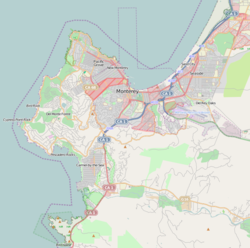Pacific Biological Laboratories
|
Pacific Biological Laboratories
|
|

Pacific Biological Laboratories logo of Ed Ricketts
|
|
|
Location in the Monterey Peninsula
|
|
| Location | 800 Cannery Row, Monterey, California |
|---|---|
| Coordinates | 36°37′1″N 121°53′59″W / 36.61694°N 121.89972°WCoordinates: 36°37′1″N 121°53′59″W / 36.61694°N 121.89972°W |
| Area | less than one acre |
| Built | 1937 |
| Architect | Oneweiler |
| NRHP Reference # | |
| Added to NRHP | December 29, 1994 |
Pacific Biological Laboratories, abbreviated PBL, was a biological supply house that sold preserved animals and prepared specimen microscope slides, many of which were of maritime aquatic species, to schools, museums, and research institutions. It was located in a building on what is now Monterey's Cannery Row on Monterey Bay in Monterey County, California.
The building, activities, and business were fictionalized as "Western Biological Laboratory" by John Steinbeck in his novel Cannery Row, as was a character based on one of its founders, Ed Ricketts.
The company was started by Ed Ricketts with his college roommate and business partner Albert Galigher in 1923. Originally located in Pacific Grove at 165 Fountain Avenue, the lab was moved to 740 Ocean View Avenue, Monterey, California around January, 1930, where Ricketts became sole owner. Today, that location is 800 Cannery Row. After Ricketts developed marital problems with his first wife Anna, the lab served as Ricketts's home for some time beginning in 1936.
On November 25, 1936, a fire broke out at the Del Mar Cannery next to the lab (site of today's Monterey Bay Aquarium) and most of the contents of the laboratory were destroyed. The manuscript for Between Pacific Tides survived the fire as it had already been sent to Stanford University for publication. It was Steinbeck that saved the lab financially after the fire with the purchase of half the company's stock.
The onset of World War II led to the decline of the commercial operation of the lab. However, the legacy of the specimens collected and distributed by PBL lives on. Museums throughout the United States contain specimens collected by Ricketts, including the Field Museum in Chicago, the Smithsonian Institution, the California Academy of Sciences, the American Museum of Natural History, the Museum of Comparative Zoology at Harvard University and the Museum of Zoology at Lund University in Sweden.
...
Wikipedia

